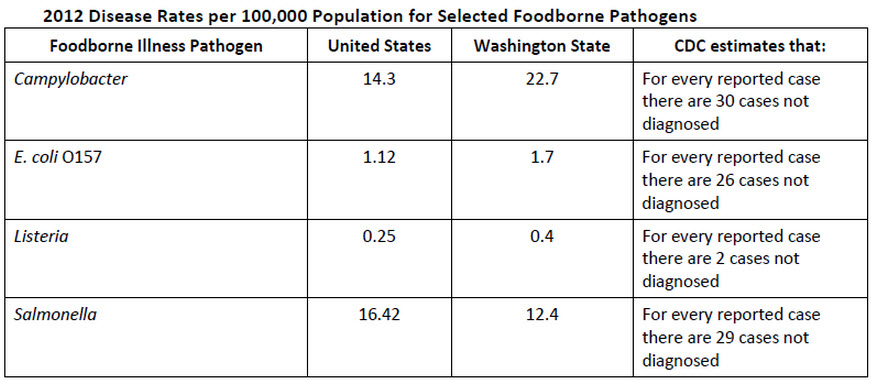Archived: Food borne illnesses
Data source: Washington State Department of Health's Annual Communicable Disease Report: http://www.doh.wa.gov/DataandStatisticalReports/DiseasesandChronicCondit...
No Information
In Washington, more than one million people become ill each year due to foodborne illnesses, with the very young, the very old, pregnant women and people with weakened immune systems being particularly at risk. In some cases, these illnesses can result in kidney failure, chronic arthritis, brain and nerve damage and even death. It can also be expensive, with the annual cost for foodborne illnesses in Washington estimated at up to $1.6 billion.
The following table lists reported disease rates and an estimate of the number of unreported cases for selected foodborne illness pathogens:

Preventing foodborne illness requires a strong partnership among food safety regulators (federal, state, local), food processors, food handlers (restaurants, homes) and consumers.
Source: Washington State Department of Health, Annual Communicable Disease Summary
It appears the number of reported foodborne outbreaks has generally decreased over time, while the number of cases associated with the outbreaks still varies. A foodborne outbreak is defined as two or more cases of the same illness resulting from eating a common food implicated as the source of illness. In Washington, there are typically 30 to 50 outbreaks of foodborne disease reported every year.
WSDA is using a risk-based approach to inspecting the food processing facilities it licenses. Firms are assigned a risk category of from 1 to 4, with 1 being “low” and 4 being “critical.” An example of a “critical” firm (4) could be a dairy selling their raw milk in the retail market. They are visited monthly to collect samples of their product for the presence of certain foodborne illness bacteria. An example of a “low” risk firm (1) could be a firm making candy or cookies.
Major food categories identified as causing foodborne illness are produce; meat and poultry; dairy and eggs; and fish and shellfish. Each month the Food Safety Program selects a high risk ready-to-eat food to sample and the field staff collects approximately 20 samples per week from the retail marketplace (e.g., leafy greens, cheese) for pathogen testing.
If you are a food processor, follow all the regulations required of you to ensure the food you are preparing is safe for public consumption: www.agr.wa.gov/FoodAnimal/FoodProcessors
If you are a member of the general public, follow the five food safety basics to help prevent foodborne illness:
Practice good personal hygiene
Cook foods adequately
Avoid cross-contamination of raw and cooked foods
Keep foods at safe temperatures—less than 40 degrees or over 140 degrees Fahrenheit
Avoid foods and water from unsafe sources
If you are concerned about a food product or believe you became ill from a food product, report it: http://agr.wa.gov/FoodAnimal/Food-complaints.aspx.
Reported by: Washington State Department of Agriculture
